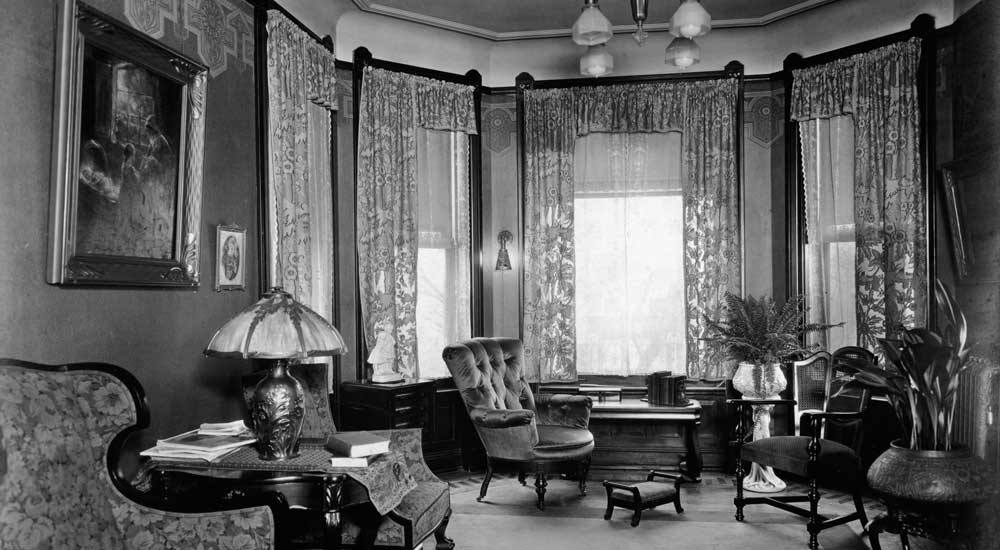Text contained on the images or in the Library of Congress descriptions was included for the images in Albums 5 & 6.
Monthly Archives: January 2008
Holder for Long Stem Flowers – Patent 1,664,436
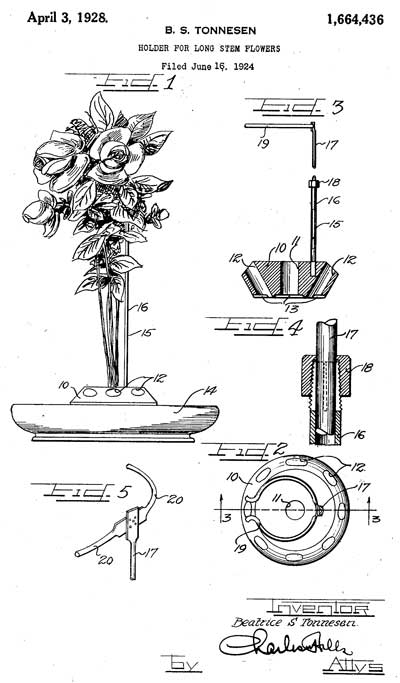
Patented Apr. 3, 1928 1,664,436
United States Patent Office
Beatrice S. Tonnesen, of Chicago Illinois
This invention relates to flower holders. It is customary in connection with rose bowls and the like to place in the bowl a perforated block into which the stems of the flowers may be inserted for support. This arrangement while suited for short stemmed flowers is not adapted for long stemmed ones.It is an object, therefore, of the present 10 invention to provide a holder or support for long stemmed flowers.
Other and further important objects of this invention will be apparent from the disclosures in the accompanying drawings and the following specification.
The invention (in a preferred form) is illustrated on the drawings and hereinafter more fully described.
On the drawings: –
Continue reading
Trenton Times, Wednesday, June 26, 1901
The twelve images offered are in the small print of the graphic. They are: Grandma’s Tea, The Waif, The Rose, Husking Time, Reflection, Bubbles, Easter Tide, The New Baby, Our Pet, Old Harpist’s Treasure, Baccante, and Delores.
Note the discussion of the use of the platinum print process for the images, also known as a platinotype.
For Trenton Times Readers
Great Offer for Old and New Subscribers Magnificent Art Collection Free, DELIVERY CHARGES ONLY COST Three Months’ Subscription to the Times and Twelve Tonnesen Pictures for a Dollar. Sample of the Pictures on Display Magnificent Works of Art.
The management of the Trenton Times believes that nothing is too good for its patrons.
An evidence of this is an offer which is now made to new and old subscribers. It is an offer unparalleled in the local field and an offer in which every one will be interested.
The offer is that of a set of twelve reproductions of the famous Tonnesen art pictures for the unheard of price of twenty-five cents and three months’ subscription to the Times at the usual rate.
In other words, on the payment of $1 the pictures will be delivered free at once and the purchaser becomes a subscriber to the Times for three months.
FOR NEW AND OLD SUBSCRIBERS
Persons who are now subscribers may pay the dollar and secure the pictures as well as extending their subscription three months ahead.The regular price of the Times is twenty-five cents a month, or seventy-five cents for three months. The additional twenty-five cents is for the packing and delivering of the pictures, the pictures themselves being given absolutely free.
Continue reading
Slideshow Album 7 – Introducing the Tonnesen Models Part 1
Slideshow Album 7 showing 10 images and descriptions which accompany “Introducing the Tonnesen Models Part 1” has been posted.
Introducing the Tonnesen Models – Part 1
“Then destiny struck in Chicago; a photographer named Beatrice Tonnesen used pictures of live girls in ads for the first time…By the end of World War I, the rush to put women in ads was on.”
-Time Magazine
September 19, 1949
P. 89
Beatrice Tonnesen, assisted by her sister/business manager Clara, revolutionized the world of print advertising. Not only is Tonnesen reported to have pioneered the use of live models in advertising around the turn of the last century, she reportedly also operated as a modeling agency, thereby controlling access to some of the era's most photographed faces…and all of that was in addition to her prolific contributions to the world of calendar art.
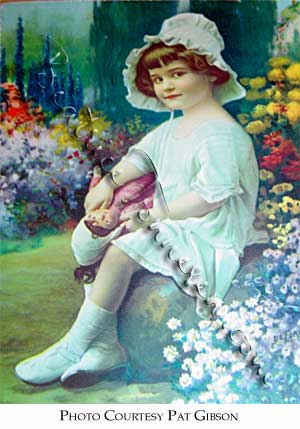 Given her reported work as a modeling agent, it’s quite possible that when we come across the likeness of a Tonnesen model in a work produced by another studio, it is because Tonnesen or someone employed by her, assigned the model to that project. Photographers aren't often identified, either in print ads or in calendar art, but, so far, I have found Tonnesen models in works attributed to four other photography studios of the era: the Keedy, Riel, Stadler and Alsop Studios.
Given her reported work as a modeling agent, it’s quite possible that when we come across the likeness of a Tonnesen model in a work produced by another studio, it is because Tonnesen or someone employed by her, assigned the model to that project. Photographers aren't often identified, either in print ads or in calendar art, but, so far, I have found Tonnesen models in works attributed to four other photography studios of the era: the Keedy, Riel, Stadler and Alsop Studios.
For that reason, when it comes to determining whether or not an image originated with Tonnesen, the presence of a Tonnesen model alone is not sufficient. (See “Identifying Tonnesen's Work…” for other identifiers.) But it's a very good start, and for that reason, I set about the work of identifying her models a couple of years ago.
This series of articles displays images of Tonnesen’s more commonly featured models. (We’ll display images from some of her print ads in a future post.) My primary objective is to show these models from various angles in a variety of settings to help make them more recognizable for the purpose of identifying Tonnesen's works. But I also am hopeful that someone out there will recognize an ancestor's face or name, or, even more exciting, him or herself. Tonnesen produced calendar art until around 1930, so some of the child models might very well be living. Everytime we identify a model or find a model's family, we have the potential to learn something new. The models seem to have shared their memories with their families, and passed down souvenirs of their careers which are rich in information about Tonnesen's work.
In this first installment, we'll take a look at the work of child models Virginia Waller and Janie Burkhardt (or Berkhauer) and Jean Blackwell, who often portrayed the mother. The images accompanying this article appear in Slideshow Album 7 along with explanatory captions. I have no biographical information on Janie or Jean. But, I've found that it adds meaning to the artwork when we recognize and reflect on the fact that our treasured prints feature real people who lived real lives. With that in mind, Virginia's story appears below.
Virginia Waller Wicks
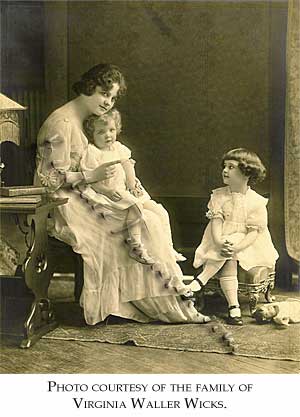 Born March 1, 1913, Virginia Waller (shown here with Jean Blackwell and Janie Burkhhardt/Berkhauer) began modeling when she was only three years old. Her son, Ken, remembers Virginia telling him that she and her mother were shopping in a Chicago store when Beatrice Tonnesen approached and asked if Viginia might be allowed to model for her photos. By that time, Tonnesen had a booming business providing images for print advertising as well as calendar art. Virginia became a familiar figure in the so-called “Cult of Motherhood” genre that was gaining popularity in illustration art in the late teens and 20's. Her short bobbed hair, dainty dresses and patent leather Mary Janes were emblematic of children's fashion of the era. Indeed, in my experience, Virginia seems to have been the most photographed of Tonnesen's child models.
Born March 1, 1913, Virginia Waller (shown here with Jean Blackwell and Janie Burkhhardt/Berkhauer) began modeling when she was only three years old. Her son, Ken, remembers Virginia telling him that she and her mother were shopping in a Chicago store when Beatrice Tonnesen approached and asked if Viginia might be allowed to model for her photos. By that time, Tonnesen had a booming business providing images for print advertising as well as calendar art. Virginia became a familiar figure in the so-called “Cult of Motherhood” genre that was gaining popularity in illustration art in the late teens and 20's. Her short bobbed hair, dainty dresses and patent leather Mary Janes were emblematic of children's fashion of the era. Indeed, in my experience, Virginia seems to have been the most photographed of Tonnesen's child models.
Virginia modeled regularly for four years, roughly 1916-1919, but she evidently returned periodically over the years for “guest appearances.” Her family has a few photos of her that seem to have been taken in her teenage years.
Virginia went on to graduate high school and work as a billing supervisor for fourteen years before becoming the wife of Willard Wicks and the mother of Kenneth and Sharon. She fondly remembered her work with Beatrice Tonnesen, and was proud of the beautiful photographs in which she had appeared. A few months after Virginia's death in October, 2006, the family held a memorial service in New Mexico where she and her husband had retired. The service featured displays of photos and prints showing the young Virginia happily portraying the model child that she was.
Coming soon:
Part 2: Images of William Redmond (1908-1992), the child model who later became Speaker of the Illinois House of Representatives; his recollections of the thriving photographic art studio scene of his youth. Images of Betty Crowe (1910 – ); what she has to say about working with Beatrice Tonnesen, Virginia Waller and William Redmond.
Part 3: Images of other models frequently featured in Tonnesen's works with approximate timelines.
Part 4: Turn of the century models – those found in the black and white newspaper Sunday supplements and those elaborately framed Victorian parlor scenes.
All Content Copyright 2008 Lois Emerson
Beatrice Tonnesen Introduced New Trend In 1890 Advertising
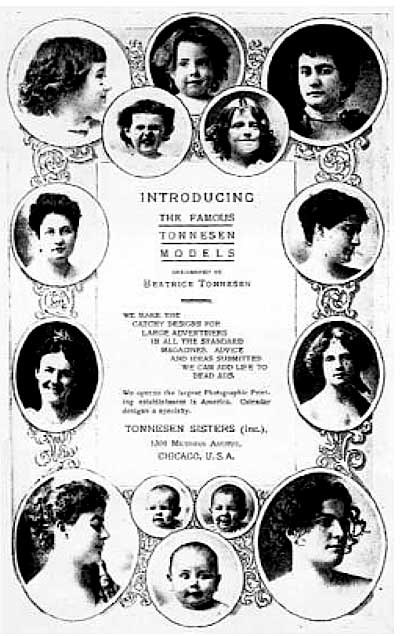 Following is a reprint of an article in the Oshkosh Daily Northwestern from Wednesday, September 29, 1954. The image of The Famous Tonnesen Models is from an advertisement in the 1903 issue of Profitable Advertising. Admittedly it is of poor quality. I am looking for an original to properly reproduce for a Zoomify image.
Following is a reprint of an article in the Oshkosh Daily Northwestern from Wednesday, September 29, 1954. The image of The Famous Tonnesen Models is from an advertisement in the 1903 issue of Profitable Advertising. Admittedly it is of poor quality. I am looking for an original to properly reproduce for a Zoomify image.
Beatrice Tonnesen Introduced New Trend In 1890 Advertising
Photographer, Oshkosh-Trained, Wins World Renown
Author Turner says that in the pages of “Advertising Experience”, published in Chicago in 1899, “There were captivating advertisements by Beatrice Tonnesen of Chicago who pioneered the use of live models in advertising. She offered for photographic purpose an unlimited range of beautiful and fascinating women, handsome men and pretty, bewitching children.' ” The author points out that one of her fascinating women was shown, dressed only in a skin-clinging union suit, tugging at the grips of an exerciser. But, he says, “More conventional were Beatrice Tonnesen’s pictures of dining cars on the Chicago, Burlington and Quincy Railroad, in which all the tables were occupied by Tonnesen models, looking no less poised and well-bred than the young women who are photographed in stratocruisers today.”
